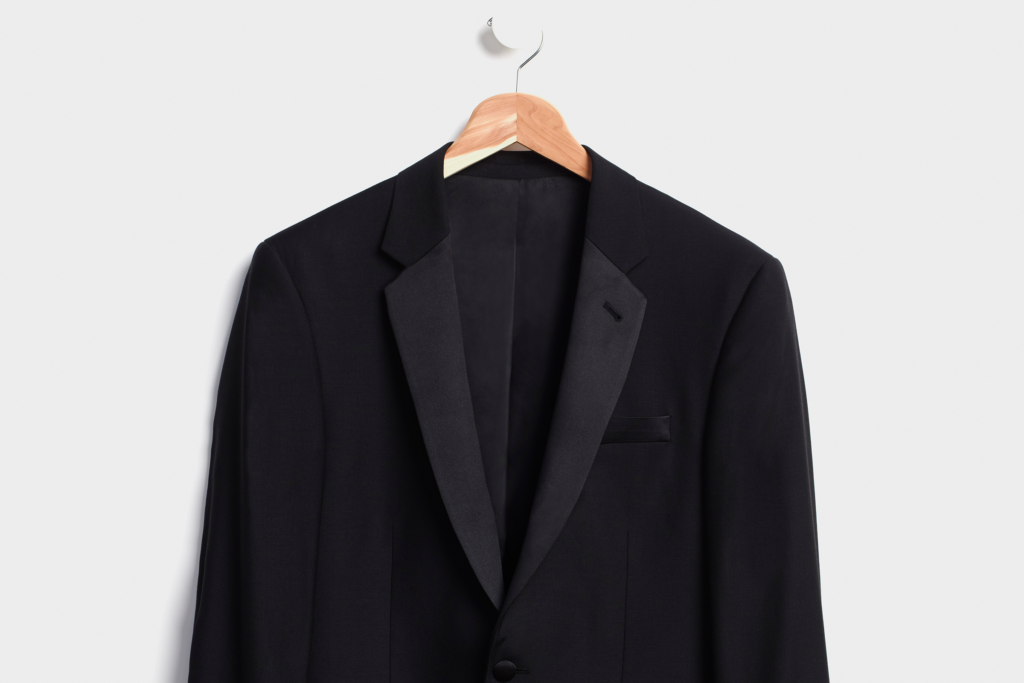If you absolutely must learn how to measure jacket size, we'll show you. It's pretty boring, and there are easier methods to finding your jacket size measurements—we'll also show you those alternatives, just in case. Read on to get your jacket size and fit just right.
Table of Contents
Understanding Suit Jacket Sizes
Before you learn how to measure jacket size, there are a few things you need to know about reading suit jacket sizes.

Jacket Chest Sizes
The size label on a suit jacket will include a number—typically between 34 and 52—and a letter or two. The numbers are the chest size of the jacket, and usually they’re offered in even sizes.
Jacket Length Sizes
Jackets typically come in short (S), regular (R), and long (L) lengths, although some brands offer extra short (XS) and extra long (XL) lengths as well. Usually, these lengths correspond with your overall height.
How to Find Your Jacket Size (Without Measuring)
Try Jackets On
As long as you understand how a suit should fit, trying on jackets is an easy way to find your sizes. Make sure you’re wearing a dress shirt, and try on as many jackets as you need until you get the right fit. You still may want to visit a showroom or store (or get a home try-on), but you won't need measurements.
Be sure to write the sizes down, and keep an eye on the "cut"—typically "slim" or "classic" noted on the jacket size tag. You'll notice the difference if you get the wrong cut later.
Use Our Fit Technology
The days of using the internet to teach your dog how to measure jacket size are over. Proprietary fit and sizing technology (like ours) makes it easier than ever to find your suit jacket sizes.
For many people, their own suit sizes are a little mysterious. That's okay—we ask simple questions that most people already know the answers to: height, weight, age, body shape, and shoe size. If you know anything about your fit preferences (slim, classic, etc.) or formalwear sizes, we’ll use that too. (If not, that’s fine.) Then, we use data gathered from hundreds of thousands of customers to calculate the most probable sizes for your perfect fit.
Anyone can do it—try it out now for free.
How to Measure Jacket Size
Use a Tape Measure
Did someone ask you to rent from a traditional brick-and-mortar tux shop, and these measurements are required? We've got you. Below you'll find instructions for taking the most common jacket measurements—be as accurate as possible for the best results.
Need a tape measure? Grab one here.
Shoulder Measurement
Wear a shirt that fits you well, and measure the distance between armhole seams across your back.
Sleeve Measurement
Keep your shoulders relaxed and arms down at your sides. Hold the measuring tape at the edge of your shoulder (the armhole), and measure straight down to where your wrist meets your hand.
Chest Underarm Measurement
Wrap the measuring tape under your arms and measure around the widest part of your chest. Don’t puff out your chest or flex, big fella.
[embed]https://vimeo.com/55957710[/embed]
Chest Overarm Measurement
Like measuring your chest, but instead of going under your arms, wrap the tape measure all the way around the outside of your arms. Stay relaxed for this one too.
Waist Measurement
Wrap the measuring tape around your waist, just above your hips, where dress pants would normally sit. For an accurate measurement, don't measure over the top of your pants.
[embed]https://vimeo.com/55957713[/embed]
Need help taking measurements for your entire outfit? Learn how to measure for a suit here.
Tips for Getting Jacket Size Measured
While getting measured for a suit jacket at a brick-and-mortar menswear store may not sound like a "good" Saturday to you, there are benefits to stopping in—especially if you’re not confident in your ability to measure yourself, or the brand doesn't have sizing or fit technology. Expert guidance can really help.
Here's some advice for making your suit or tuxedo fitting count:
1. Always wear a dress shirt to get fitted.
This will give you a good idea of how the suit or tux jacket will fit when you actually wear it out.
2. Bring a photo of the fit you want.
If you have a specific look you're going for—slim, etc.—bring a photo for reference. If you don't, you'll have to trust the eye of the person taking your jacket measurements.
3. Don’t argue with the experts.
If they make a recommendation you didn't expect, there’s probably a good reason. Ask a few questions and get their opinion before you bail completely.
A Better Way to Find Your Jacket Size
Getting your jacket size right is important, but if you'd rather focus on the big picture and completely skip the tedious measurement-taking, we're right there with you. We weren't satisfied with the options available for finding formal wear sizes, so we created our own size calculator. It's simple, nearly instant, and backed by data and years of formal wear expertise.

We've also modernized the experience of finding your jacket size in person. Visit one of our 300+ showrooms to see our designer-quality suits and tuxedos, and get help finding the perfect fit and jacket size from our experts.









